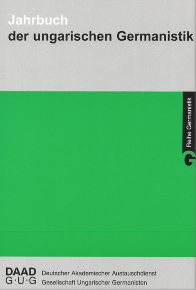Jahrbuch der ungarischen Germanistik 2024, S. 218–233.
Funktionen der bildenden Kunst im Frühwerk von Thomas Mann. Bildvorlagen in „Vision“, „Fiorenza“ und „Der Kleiderschrank“
Károli Gáspár Universität der Reformierten Kirche in Ungarn Budapest
Diese E-Mail-Adresse ist vor Spambots geschützt! Zur Anzeige muss JavaScript eingeschaltet sein!
DOI: https://doi.org/10.69962/JUG.2025.14
Abstract:
My research deals with four of Thomas Mann‘s early works in terms of their artistic aspects and their functions. My hypothesis is that in the 1898 narrative „Der Kleiderschrank“ we can identify the pictorial motifs of Sandro Botticelli‘s „La calumnia de Apelles“, a painting that has already been associated in the literature with the writer‘s early creative period, thus providing the starting point for my research. If it can be proven that the writer was familiar with this painting when he wrote the above-mentioned work, it can be assumed that the visual arts were given a similar prominence in Thomas Mann‘s early works as they were in his later works. There is currently a consensus in the literature that in his early works the pictorial motifs used play a subordinate role. Drawing on Hans Wysling‘s terminology, I will present four works in which I will examine which pictorial patterns perform a purely representational role, i. e. the writer uses a pictorial pattern to describe, for example, the external characteristics of his characters, and which pictorial patterns perform a compositional role, i. e. the relationship of the painting to the plot of the work, thus potentially opening up new interpretations.
Keywords:
Literature and visual arts, Intermediality, Thomas Mann, Sandro Botticelli, illustration, early works of Thomas Mann, aesthetics
References:
Blödorn, Andreas (2013): Farbschattierungen: Bildlichkeit im Frühwerk Thomas Manns. In: Bedenig, K./Sprecher, Th./Wißkirchen, H. (Hg.): Thomas Mann Jahrbuch. Band 26. Frankfurt a. M.: Vittorio Klostermann, S. 155–168.
Blödorn, Andreas/Friedhelm, Marx (Hg.) (2015): Thomas Mann Handbuch. Leben – Werk – Wirkung. Stuttgart: J. B. Metzler. https://doi.org/10.1007/978-3-476-05341-1.
Eilert, Heide (1991): Das Kunstzitat in der erzählenden Dichtung. Studien zur Literatur um 1900. Stuttgart: Franz Steiner.
Fliedl, Konstanze/Rauchenbacher, Marina/Wolf, Joanna (Hg.) (2011): Handbuch der Kunstzitate. Malerei, Skulptur, Fotografie in der deutschsprachigen Literatur der Moderne. Band 1. Berlin/Boston: de Gruyter. https://doi.org/10.1515/9783110256703.
Galvan, Elisabeth (2011): „Der Kleiderschrank” und seine Folgen. In: Sprecher, Th./Wimmer, R. (Hg.): Thomas Mann Jahrbuch 2011. Frankfurt a. M.: Vittorio Klostermann.
Gröttler, Anette (2019): Pikturales Erzählen. Thomas Mann und die bildende Kunst. Heidelberg: Universitätsverlag Winter.
Hagedorn, Christian Hans (1997): Ein neuer Bildfund zu Thomas Manns „Fiorenza“: „Die Verleumdung“ von Sandro Botticelli. In: Wilfried, B./Müller-Seidel, W./Ott, U. (Hg.): Jahrbuch der deutschen Schillergesellschaft. Nr. 41. Stuttgart: Alfred Kröner, S. 369–382.
Hagedorn, Christian Hans (2014): Bildende Künstler als Leitfiguren bei Thomas Mann. Beobachtungen und Forschungsfelder zur Augenwelt eines Ohrenmenschen. In: Mehring, R./ Rossi, F. (Hg.): Thomas Mann e le arti. Nuove prospettive della ricerca – Thomas Mann und die Künste. Neue Perspektiven der Forschung. Roma: Istituto Italiano di Studi Germanici, AISMANN Associazione Italiana di Studi Manniani, S. 37–70.
Kruft, Hanno-Walter (2005): Thomas Mann und die bildende Kunst. In: Koopman, H. (Hg.): Thomas-Mann-Handbuch. Frankfurt a. M.: S. Fischer, S. 343–357.
Mann, Katja (1965): Thomas Mann. Reden und Aufsätze I. Oldenburg: S. Fischer.
Mann, Thomas (1962): Briefe 1889–1936. Hg. von Erika Mann. Frankfurt a. M.: S. Fischer.
Mann, Thomas (2004): Frühe Erzählungen. 1893–1912. Band 2.2. Kommentar von Terence J. Reed unter Mitarbeit von Malte Herwig. Frankfurt a. M.: S. Fischer.
Mann, Thomas (2016): Frühe Erzählungen. 1893–1912. In der Fassung der Großen kommentierten Frankfurter Ausgabe. Hg. von Terence J. Reed unter Mitarbeit von Malte Herwig. Band 2.1. Frankfurt a. M.: Fischer.
Nietzsche, Friedrich (1988): Die Geburt der Tragödie. Unzeitgemäße Betrachtungen I–IV. Nachgelassene Schriften 1870–1873. Kritische Studienausgabe. Hg. von Giorgio Colli und Mazzino Montinari. München: DTV; Berlin/New York: de Gruyter. https://doi.org/10.1515/9783112418765.
Prater, A. Donald (1995): Thomas Mann Deutscher und Weltbürger. Eine Biographie. Wien: Carl Hanser.
Sprengel, Peter (1998): Geschichte der deutschsprachigen Literatur 1870–1900. Von der Reichsgründung bis zur Jahrhundertwende. München: C.H. Beck.
Stresau, Hermann (1963): Thomas Mann und sein Werk. Frankfurt a. M.: S. Fischer.
Szendi, Zoltán (1999): Seele und Bild. Weltbild und Komposition in den Erzählungen Thomas Manns. Pécs: Pannónia Könyvek.
Wilpert, Gero von (1994): Die deutsche Gespenstergeschichte. Form – Motiv – Entwicklung. Stuttgart: Alfred Kröner.
Wysling, Hans (1975): Bild und Text bei Thomas Mann. Eine Dokumentation. Bern: A. Francke.
